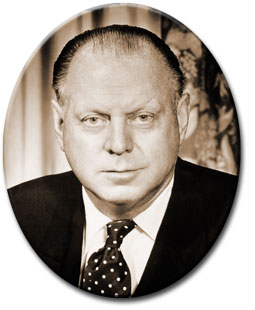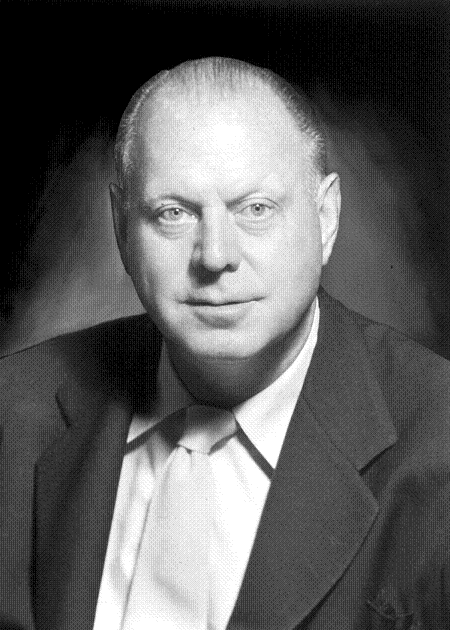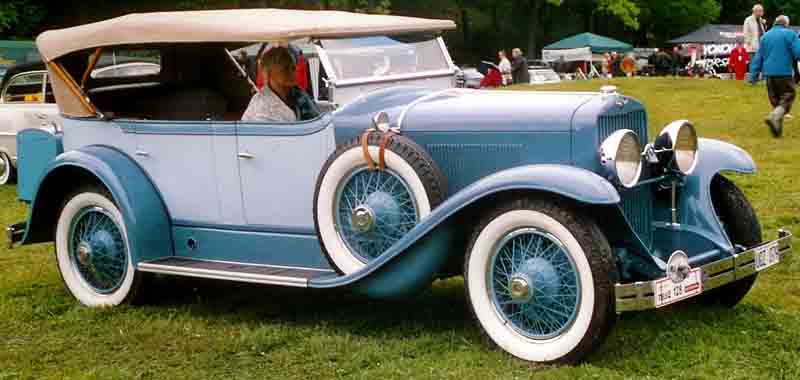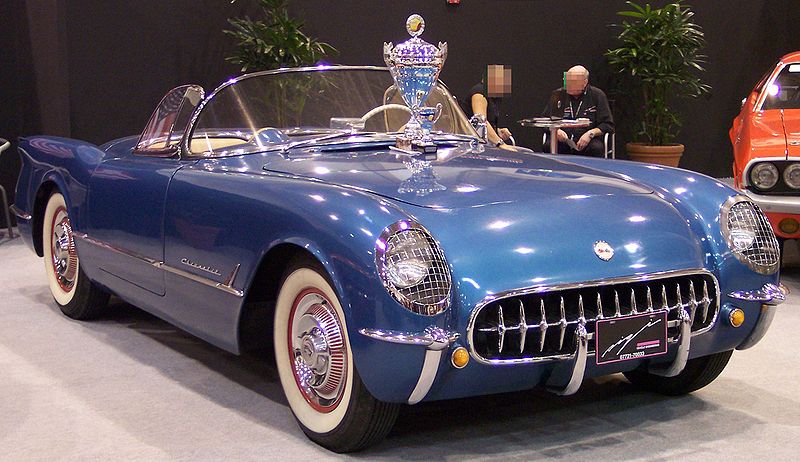<Back to Index>
- Astronomer Erasmus Reinhold, 1511
- Industrial Designer Harley J. Earl, 1893
- Président de la République Française Charles André Joseph Marie de Gaulle, 1890
PAGE SPONSOR


Harley J. Earl (November 22, 1893–April 10, 1969) was first Vice President of Design at General Motors. He was an industrial designer and a pioneer of modern transportation design. A coach builder by trade, Earl pioneered the use of freeform sketching and hand sculpted clay models as design techniques. He subsequently introduced the “concept car” as both a tool for the design process and a clever marketing device.
Harley Earl and Alfred P. Sloan implemented
"Dynamic Obsolescence" and the "Annual Model Change" to further
position design as an engine for the company's product success.
By the time that Harley Earl was near retirement, General Motors was
the largest corporation in the world, and design was acknowledged as
the leading sales factor within the automotive industry.
Nearly all of Earl's techniques and innovations are still in use today
by automakers around the world. Harley
Earl's early struggles to legitimize his design approach conflicted
with the tradition and production-oriented executives at General
Motors. Engineers, division heads, and sales executives viewed his
conceptual ideas as flamboyant and unfounded. As head of the newly
formed "Art and Colour" division of GM in 1927, he was initially
referred to as one of the "pretty picture boys", and his Design Studio
as being the "Beauty Parlor". The first concept car was Earl's Buick Y-Job, he started "Project Opel", which eventually became the Chevrolet Corvette, and he authorized the introduction of the tail-fin to automotive styling. During World War II, he was also an active contributor to the research of camouflage. Harley Earl was born in Hollywood, California. His father, J.W. Earl, began work as a coachbuilder in
1889. The senior Earl eventually changed his practice from horse-drawn
vehicles to custom bodies and customized parts and accessories for
automobiles, founding Earl Automobile Works in 1908. Earl began studies at Stanford University,
but left prematurely to work with, and learn from, his father at Earl
Automotive Works. By this time, the shop was building custom bodies for
Hollywood movie stars, including Roscoe "Fatty" Arbuckle and Tom Mix. Earl Automotive Works was bought by Cadillac dealer Don Lee, who kept Harley Earl as director of its custom body shop. Lawrence
P. Fisher, general manager of the Cadillac division, was visiting
Cadillac dealers and distributors around the country, including Lee.
Fisher met Earl at Lee's dealership and observed him at work. Fisher,
whose automotive career began with coachbuilder Fisher Body, was impressed with Earl's designs and methods, including the use of modeling clay to develop the forms of his designs. Fisher commissioned Earl to design the 1927 LaSalle for Cadillac's companion marque. The success of the LaSalle convinced General Motors president Alfred P. Sloan to create the Art and Color Division of General Motors, and to name Earl as its first director. Prior
to the establishment of the Art and Color Division, automobile
manufacturers did not assign any great importance to the appearance of
automobile bodies. Volume manufacturers built bodies designed by
engineers guided only by functionality and cost. Many luxury-car
manufacturers, including GM, did not make bodies at all; opting to ship
chassis assemblies to a coachbuilder of the buyer's choice. (Others, e.g., Studebaker preferred to build complete units.) In 1937, the Art and Color Division was renamed the Styling Division.
In 1939, the Styling Division, under Earl's instruction, styled and built the Buick Y-Job, the motor industry's first concept car.
While many one-off custom automobiles had been made before, the Y-job
was the first car built by a mass manufacturer for the sole purpose of
determining the public's reaction to new design ideas. After being
shown to the public, the Y-job became Earl's daily driver.
In 1942, during World War II, Earl established a camouflage research and training division at General Motors, one consequence of which was a 22-page document called Camouflage Manual for General Motors Camouflage. A decade before, two former World War I camouflage artists, Ledyard Towle (a U.S. Army camoufleur) and McClelland Barclay (who created the Fisher Body ads,
and contributed to U.S. Navy camouflage during both World Wars) had
worked as designers at General Motors. In addition, among Earl's
apprentices was English designer David Jones, who worked at its British
division at Vauxhall, and who served in the camouflage section of the Royal Engineers during World War II.
Harley Earl authorized the Frank Hershey design for the 1948 Cadillac, which incorporated the first automotive tailfins. Inspiration for the fins came from the Lockheed P-38 Lightning. The style caught on throughout Detroit and eventually led to competition between Earl and Virgil Exner over the size and complexity of tailfins, culminating with those on the 1959 Cadillac.
Influenced by the English and European sports cars being raced on road racing circuits after World War II,
Earl decided that General Motors needed to make a sports car. Design
work on "Project Opel" began as a secret project. He first offered the
project to Chevrolet general manager Ed Cole. Cole accepted the project without hesitation, and the car was offered to the public in 1953 as the Chevrolet Corvette.
Harley
Earl retired from General Motors in 1958 after overseeing the design of
the 1959 models. He was succeeded as vice-president with responsibility
for the Design and Styling Department by Bill Mitchell, under whose leadership GM design became less ornamental. Harley Earl suffered a stroke and died in West Palm Beach, Florida, on April 10, 1969. He was 75 years old. He
is remembered as the first styling chief in the United States
automobile industry, the originator of clay modeling of automotive
designs, the wraparound windshield, the hardtop sedan, factory two-tone
paint, and tail-fins. One of his concept car designs, the turbine powered Firebird I, is reproduced in miniature on the The Harley J. Earl Daytona 500 Trophy, which goes to the winner of that season opening NASCAR race. Harley Earl was used in a brief advertising campaign for Buick, particularly during its reconstruction period between 2001 and 2002. Actor John Diehl,
portraying Earl (or his ghost) was used to symbolize the importance of
design in Buick's cars, or as the ads put it, the "Spirit of American
Style". Earl's trademark fedora was often used as an icon in these advertisements.

